PANEL ZERO (6)
By:
August 29, 2018
Being one in a monthly series of deep-cutting, far-drifting discussions on the comicbook artform and its cultural influences, expressive aspirations and unintended consequences.
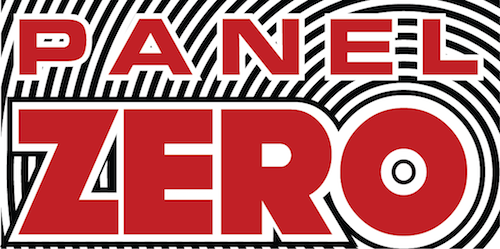
The heroes of our technological folktales are all here by accident — transmuted by radiation, resurrected by random exploration, bequeathed commands and kingdoms by unlikely catastrophes — but those who stand out in our actual world are often made to feel as if it’s an accident they’re here. Leaked between these ideal fantasies and that imperfect reality, the protagonist of Eternity Girl (a just-concluded graphic series for DC Comics’ Young Animal imprint) gets to experience all the transformation with all the exclusion too.
Special operative Caroline Sharp of the quantum secret police force Alpha 13 gets caught in the collision of supernatural and scientific forces (equally mystifying) in a climactic confrontation with cardboard nemesis Madame Atom, becoming porous with the field of infinite possibility (affecting matter’s composition, probability’s outcome, etc.), her body a patchwork of morphing genetic pieces and her being blurring between potential realities. Increasingly unable to control this gift and involuntarily retired from service, she turns to the post-superhero pastime of serial attempted suicide (which her powers themselves make essentially impossible). Until her greatest foe, Madame Atom, comes back from her own death with the solution of putting the entire reincarnating cosmos out of its misery.
Like a reverse fairy godmother she leads Caroline between planes of existence and permutations of her past, running afoul of cosmic elders like the endlessly cycling deity DJ, Lord Crash, while Caroline’s tethers back to her own personal Kansas — especially former colleague Dani, the only non-double-agent among all her friends — fray to vanishing. Exploring the multiple possibilities, rich pasts and limitless futures of the comic medium, writer Magdalene Visaggio (one of the most fresh and frenzied voices in comics this decade, acclaimed for the anarchic Kim & Kim and making her full-length DC debut here) and artist Sonny Liew (omnilingual stylist renowned for his Eisner-winning meta-history The Art of Charlie Chan Hock Chye) create an existential thriller and backstage psychodrama like nothing else. I spoke with Visaggio about bringing the Eternity Girl to life, death, oblivion and immortality…
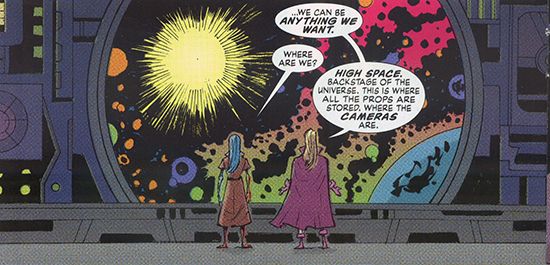
HILOBROW: Eternity Girl is like reading a mandala. How did you harmonize the simultaneous actions, the grand patterns and granular details in these radial or dispersed compositions?
VISAGGIO: Anything about the visual composition of the page was largely Sonny. Sonny was kind of notorious for ignoring stage directions and doing his own thing, and he was very much correct to do so; I was always real eager to see what he would do. The cover that he did for the second issue was sort of the introduction of that. I started writing things saying, “if you want to do something here like that, I think that would work.” But mostly he just did whatever he thought would elevate what was happening in the moment. Sonny is really an extraordinary artist, and he always found a way to make the page do more work than I was asking him to.
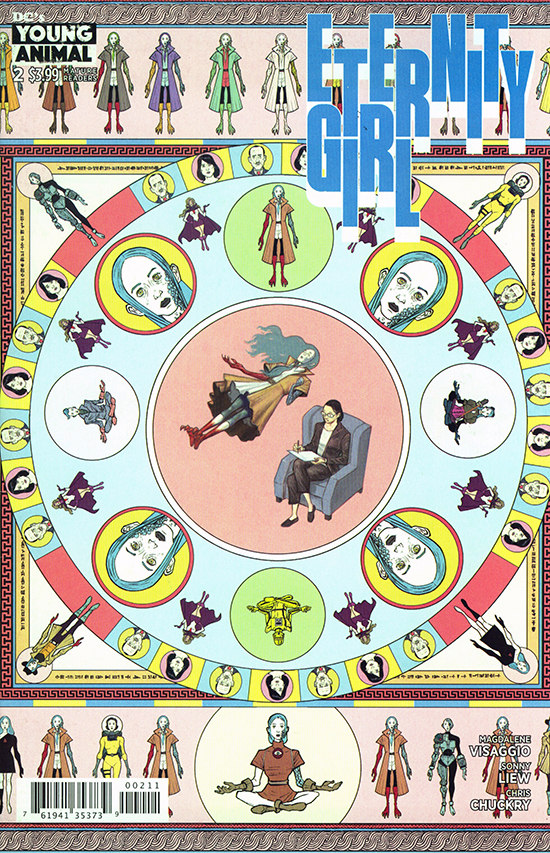
HILOBROW: Your description of the process did make me wonder if you started writing to that tendency of Sonny’s…
VISAGGIO: I always try to write for my artists, I always try to get a sense of what their strengths are. He’s also someone who is really strong with repeated imagery, and I really like doing [that]; he’d always find a way to take an image I wanted to reuse and recontextualize it in a new way. There’s this recurring image of Caroline crashing into water, and most of all there’s just images of Caroline falling. I would ask for a panel of that, and he would find a way to frame the page around it. To make what was an important image more visually central than I had imagined it to be.
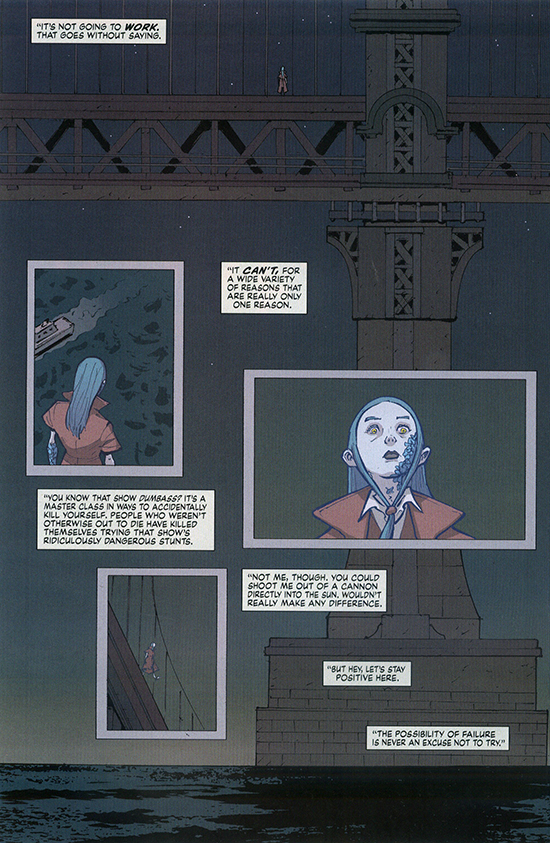
HILOBROW: I had been specifically wondering to what extent you had threaded certain motifs through the script; like, even in issue 6, we are at one point back to the scene of Caroline standing on a ledge…
VISAGGIO: That’s me, I’m a big fan of that. If you look at the first issue you see that already playing out. Something really important to me was to maintain the sense of unreality. And so, I wanted to keep conversations going, even as the setting shifted. And as the book moves on we see the conversation going even as the characters change, and you have different people continuing the conversation. [In this way] we get a sense of the different levels on which Caroline is existing. It’s doing different work [at different points]; later on, we’re deep in her dual-track existence, but in the first issue everything’s all a jumble and that’s the point. In the first issue we keep returning to the ziggurat [the mythic locale of Caroline’s catastrophe], again and again and again and again — because she can’t get away from the circumstances of her creation. But then Madame Atom shows up and compels her in this new direction.
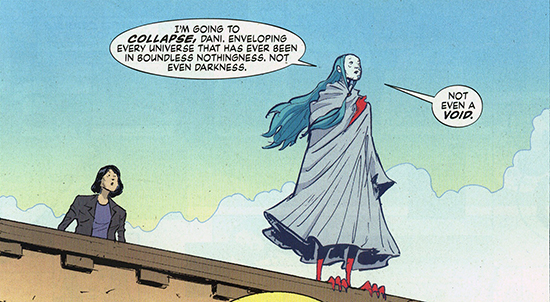
HILOBROW: I agree about the different direction; it seemed to me that, even though the whole theme, and particularly Madame Atom’s fixation, is to break a never-ending cycle, to me it feels like she and Caroline are the only ones who do forge a new path — the more establishment characters like Rick feel to me like the ones who are out of time, never changing or trying to. Rick literally looks like he’s a cutout from some old comic. Is it that the more constant you are, the less real you are?
VISAGGIO: I can see that. That wasn’t a conscious thing, [though]…what we were going for was never to make Caroline feel like she’s the most real, and make everyone else feel like they were receding; I wanted Caroline to feel out of place. I wanted the reader to feel Caroline’s displacement. You’ll notice there’s a blue color-hold on her, all of her outlines are blue, and everyone else’s are in black, so she doesn’t even fit in the setting. She doesn’t even fit on the page. She is the chaotic element; the one that everyone else is trying to get control over, because of what she represents.
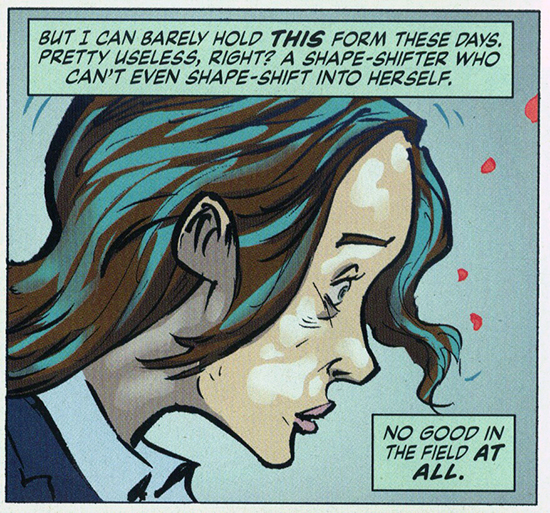
HILOBROW: Which makes it ironic that, almost to the end, Caroline has such a single-minded purpose; it takes her friend Dani, at the end, to remind her about the joy of possibility, the unpredictable…
VISAGGIO: What’s important is that her single-minded purpose isn’t her purpose. It’s Madame Atom’s purpose. Up until the very very end, she’s being used. She’s being pushed around, she’s being dragged. She’s someone who doesn’t know how to give herself purpose, she only knows how to take purpose from other people. And so the choice, the recognition that she, more than anybody else in the world, has the ability to dictate her own destiny — that’s significant, because her purpose, for the first time, is hers.
HILOBROW: And her first decision was to give up control to Madame Atom, so the final choice is in some ways her first, or at least the beginning of her fullest life. That’s a powerful metaphor, ’cuz as you say, she has limitless potential to change her life, which is why as many people as possible want to be inside her head, making her interests secondary.
VISAGGIO: That’s exactly true. In the fifth issue, there’s the metaphor of the weapon. All a weapon is, is “force, speed and timing judiciously applied.” And it’s all about being used. And being so committed to a course of action and a purpose that you just become an instrument of that thing. And what we learn is that Caroline’s whole life has been that. Her whole life has been her striving toward some [outer] thing, and not just existing…she gets out of college, and she joins Alpha 13, and she’s done all her missions and she’s fighting Madame Atom and then she has her incident and suddenly that’s taken away from her. She doesn’t have anything, because she doesn’t know how to give herself purpose, she doesn’t know how to have, or address, or find meaning for herself. So the metaphor of the weapon, of being an instrument, of being under someone else’s control, is fundamental to understanding her. She’s someone who has never let herself be in control.
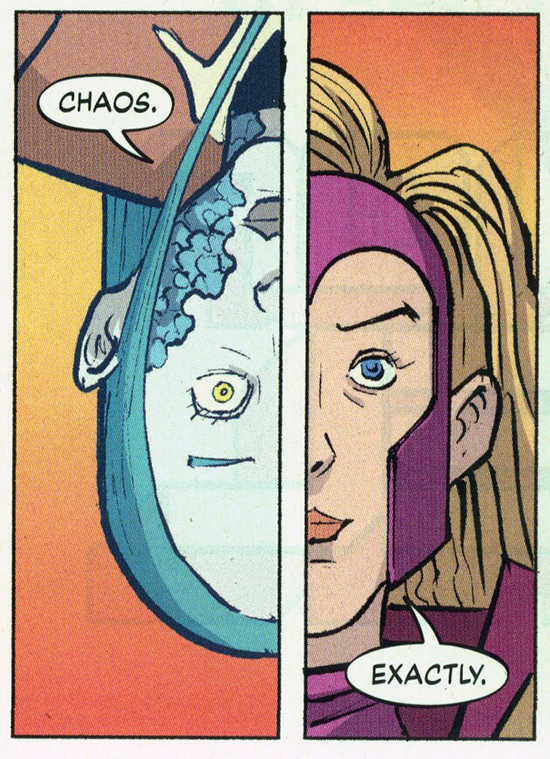
In the first draft, and I cut this because I felt it didn’t flow, but there was a lot of discussion about how much of that was driven by her parents, how much of that was something that was foisted upon her, was a pattern that she was put into. I kinda wish we’d kept it but it kinda bogged down everything.
HILOBROW: And her therapist fills us in on that pretty comprehensively I think; when she says “I’ve read your file, Olympic gymnast, two master’s degrees,” etc. I thought yeah, this is a person who was always burning themself up to please everyone else. Another reason I like the way it did come out was that, everything that ever felt like it went right for her is lopped off and has fallen away before we even meet her. Which grants a very palpable sense of lostness and isolation and uncertainty that pervaded the book for me in very meaningful and vivid ways.
Speaking of meaning, this story was one of the few works of culture that have given me what feels like a religious experience, even though it’s based in theoretical science. You’ve spoken elsewhere about how you once studied for the priesthood; how close are physics and the metaphysical in your mind now?
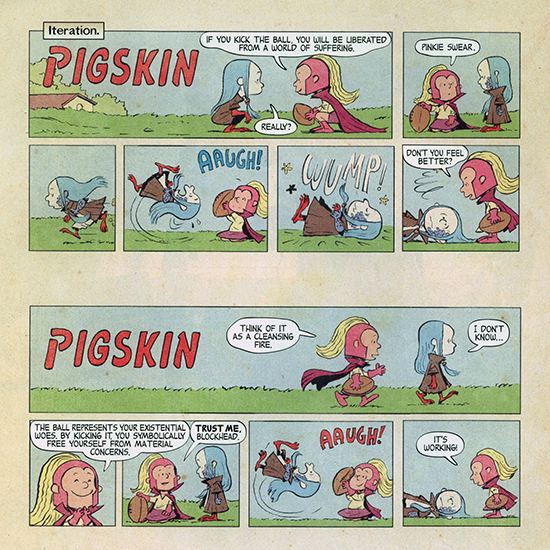
VISAGGIO: I did go to seminary, I did try to be a priest. One thing I was thinking about earlier today, was that I think that it’s almost to be expected that Trans people are a little philosophical? Because there aren’t many classes of people who have such a motivation to contemplate the nature of their own existence. And on a really visceral level; not just on a “why am I here,” but more of a “why does my life not make any sense ever” kind of way.
And a lot of us dive into religion, a lot of us dive into all kinds of different ways to cope with that. And, for the last couple years, since my transition, I’ve kind of lost my religion, which is a hard thing to recognize, but it’s true, and I’ve gotten very much into a philosophy of choice. You asked about how technology and spirituality interrelate in the universe; I don’t know how to talk about that, but I know how to talk about myself and my existence. Because I think to me that’s the heart of it. I used to worry all the time about the metaphysics of things, and about ethics and about The Good, and I still do to an extent, and I’m still into Aristotle and Kierkegaard, and a few people have commented that there’s a strong Kierkegaardian reading to the book that’s there to be done.
And that’s cool, but for me, my focus is on choice. The only life that I have is my life. I don’t have another one, and the only person who has control over that is me. And my existence is the entire universe as far as I’m concerned. I don’t mean that in a solipsistic way, saying that there is nothing else, but I don’t have access to anything other than me. I don’t have access to your eyes, or to your feelings, or your memories, I don’t have access to your likes, to your dislikes, except inasmuch as you express them to me in one form or another. You have an entire inner life going on in your head right now and that’s your whole universe — everything from being happy to mourning, all those things that inflect your entire existence, and affect how you live, in the universe.
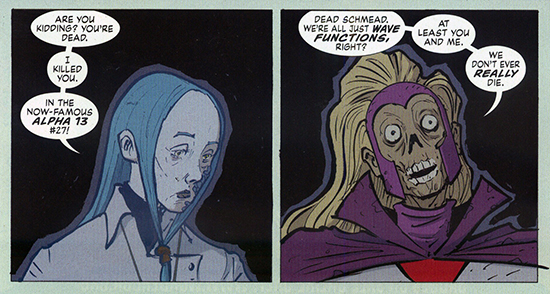
So we can talk about the crazy shit going on in space, we can talk about alternate realities, we can talk about the multiverse, but what we’re really talking about are just people living their lives, and making choices on how they want to live. So for me, the thing that I’ve learned the most, since transitioning, since leaving Catholicism, has been that I have to be able to live with my choices. I think that choices have a really profound metaphysical meaning, because your choices affect the whole universe. The title of the last issue is “We Are Made of Choices” — and those are my choices and your choices and everybody’s choices. Characters are just big bags of decisions that a writer makes, and in a very real way all we are is the sum of our choices, and how our choices have been inflected by other people’s.
So you look at Caroline, and there’s this line that’s repeated a couple of times throughout the book, which is that “I am a wave function.” And we get to pick the shape of that wave function. This is something I really was obsessed with toward the end of my time in seminary, when I was really really really seriously thinking I was gonna transition: I got really obsessed with the idea that a wave moves through the water, but the water doesn’t move. The wave just picks up the water as it goes. But [what’s important] is the pattern, not the matter.
And so I started thinking to myself, well, I shed skin cells, I eat, and I vomit and I shit and I piss, and I take in matter, and I lose matter; I bleed and that matter’s gone from me; I eat and that matter’s a part of me now. I’m just a pattern that picks up and sheds matter over time. And the shape of that pattern is something that I can consciously affect. But the nature of my existence is that pattern. And being a wave function, being a pattern — recognizing that I am not solely my material circumstances was a really profound revelation for me, about how I relate to the whole universe. Because that’s all anything is, is just a system or a pattern that’s churning, taking in things and shedding things as it goes. I don’t know if I’ve answered your question at all.
HILOBROW: My favorite answers are the ones to questions that weren’t asked! Speaking of moving beyond Christianity (or other specific spiritual frameworks), as a lifetime Kirby worshipper I’ve always been fascinated by that idea of divine beings with contemporary attributes, and I thought it was particularly inspired to have Crash, a cosmic turntablist, personifying this sense of constants which are nonetheless eternally refreshed…
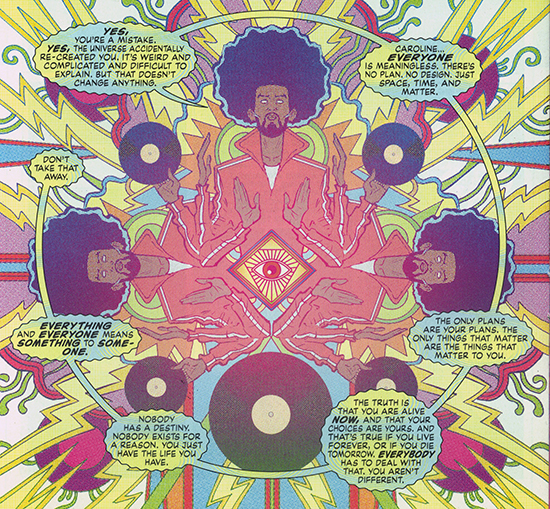
VISAGGIO: What’s really funny, Crash is a fairly late addition. Originally the Lord of Order was a kind of generic, kind of Kirbyesque astral figure, that I called Vataka. And Vataka didn’t have any characteristics or properties, he was just there to be this god and I was so bored, I didn’t like writing him. But at the same time I was watching The Get Down, and just listening to Grandmaster Flash talk about how he developed turntable techniques just fascinated the shit outta me. And I’m just thinking, this sounds like everything I’m trying to do [with] this book, but in music. Like, taking existing elements, and seeing how they fit together in weird ways. That to me was Crash’s whole deal, he was just infinite possibilities, and there were infinite possibilities in those infinite possibilities. And I imagined, what if Grandmaster Flash had an infinite turntable and an infinite number of records; he could make the whole universe. And so I ended up sort of making “Crash” out of “Flash” ’cuz I wanted the name to have the same zing to it. My favorite thing is hearing people operating at a high level of what they do, talk about their work. There was just something about the concreteness of Grandmaster Flash’s sort of workmanlike approach to hip-hop, just approaching it as like, what he does with the tools he has, that resonated with what I was trying to do in the book. And so I brought him in. And then I made him a god!
HILOBROW: Crash is like a modern-day Norn, but playing out possibilities along the spiral of an old vinyl record’s groove instead of a loom of our lifelines.
VISAGGIO: When you think about [ideas] like the Norns, when you think about the image of weavers in mythology, it’s the same thing of people taking contemporary aspects of their lives and applying them in eternal ways. So, you’ll get gods who are smiths, gods who are weavers, gods who are hunters, gods who are archers; those are just things that the ancient world had around. And if you look at Neil Gaiman’s American Gods you’ve got, y’know, the god Media. I think that’s so chill, but even that I thought felt too big; why isn’t there a DJ god, why shouldn’t there be? Why shouldn’t the muck of real life be elevated like that?
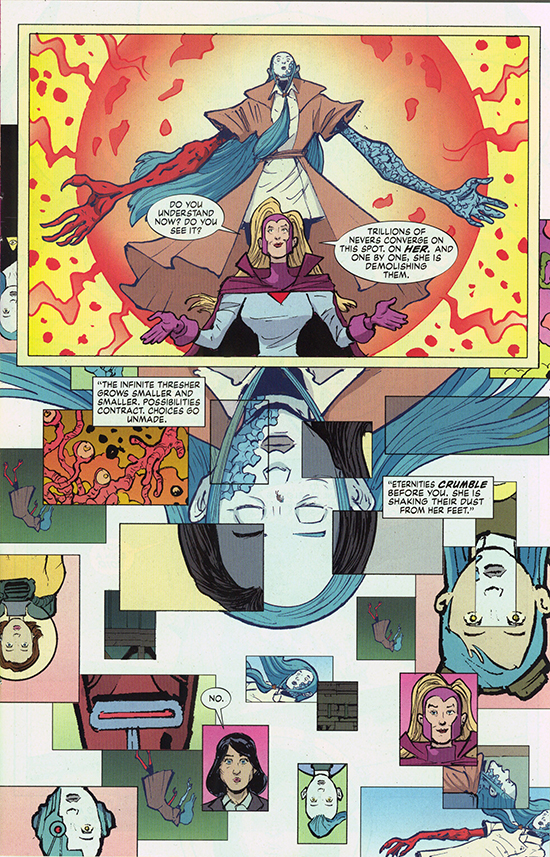
HILOBROW: As I was reading this book it really gave me the impression of being the first application in a comic of Nick Sousanis’ theories on comics — from Unflattening, his thesis on cognition, done in comics form, proposing the totality of time as an overall composition that we can move between in concentrating on panels, potentially in different directions and combinations…a unique treatment of simultaneity and granular focus. Nick’s compositions are mindblowing yet lucid, in terms of sending messages with the overall pattern of the page, while being very rewarding with the contingencies of meaning you get by focusing on different elements of that composition. Eternity Girl is the first comic that gives me that feeling of spherical time. Our minds taking in multiple stimuli and assembling meaning in varying ways.
VISAGGIO: What I enjoy about Young Animal, especially my book and Shade, The Changing Girl, is that we’re playing with structural work that I don’t see done in comics a lot. Every year DC does this Master Class, around New York Comic Con, and this year it was given by Grant Morrison and I had the opportunity to go. And he starts talking about the mechanics of the comic page, and how people read it, and how that has changed over time, and how that has changed how we have to write comics. And he started taking about, and this blew my mind, how — you know when you’re online, and you’ve got like eight tabs open, and you’re switching back and forth? And he’s like, “comics is the only medium that could do that.” I’d already started Eternity Girl, and I felt like it was already starting to do that work, but that talk really influenced the way that I started to parse out Caroline’s two paths: that they were basically the two tabs, and we would switch back and forth. And they would inform each other — not in this way that, y’know, your CNN tab’s informing your webcomics; you’re reading both, and that’s informing you. So, I wanted the open tabs to sort of swirl around each other in that same way, where your understanding of what’s going on is affected by what’s happening in each one. And they don’t touch ’til the very end.
Eternity Girl is the first book where I had to think about the page as a cohesive…not just as a narrative unit, but as a visual unit. That’s one of the reasons I wanted Sonny on it, ’cuz I knew that element was gonna need to be in there, with the way we were jumbling images, the way that I wanted this book to behave. One of the things that Sonny brings to the book is that every page is a visually coherent experience. The visual meaning he’s able to pack into a page such that it elevates my script so dramatically never ceases to amaze me.
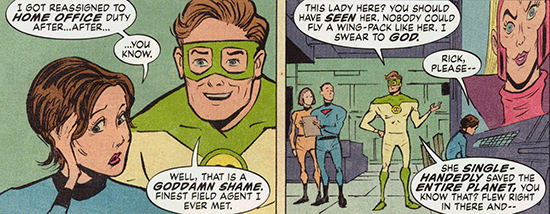
HILOBROW: It’s phenomenal, and gives me such a feeling of the page moving before my eyes, because there’s so much to look for.
VISAGGIO: I can’t tell you how many times I was blown away, even by his sketches, his thumbnails of how he was planning on conveying a scene visually. In issue 6, there’s a little two-page sequence when Dani enters the Shining Tower, where we see this whole array of alternate Danis. I just wanted her to walk into a room and they were all standing in a circle. And it was Sonny who was like, I’m gonna draw 36 fuckin’ panels, with each individual one of them on every single page of this sequence. And that gives the reader the sense of being visually overwhelmed, while also giving the reader the opportunity to peruse every single one of the individual details. And it also elevates the sense of unreality, in that none of them are situated in space. She walks into a room, and you don’t know that she’s seeing it, you just know that she’s getting the sense of it. And that heightens the unreality that we have going into it, because you’re just smacked in the face with, “This is a really weird situation,” and you can’t assume anything about space, or time, or how they interrelate.
HILOBROW: It’s kind of like his composition is that intersection between technological and mystical — like blueprints for endless possibilities.
VISAGGIO: That’s one of the things I love about comics, that the page is a unit, and doing this book taught me to appreciate that in a whole new way, that the page, as a narrative unit, is a thing that only exists in space, and so time doesn’t mean shit, because space becomes…time becomes an element of space. And space becomes an element of ontology, and epistemology, and of meaning. So the way those all interrelate is something that I think Sonny gets on an extremely high level that very few creators do. I’m not even saying I do.
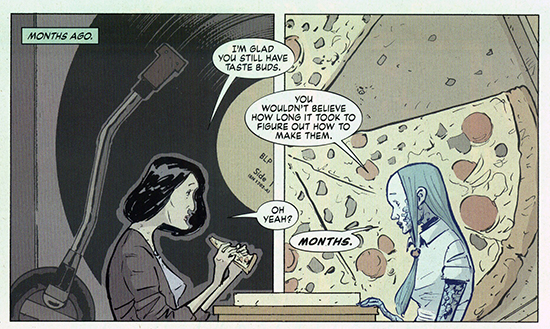
HILOBROW: I was profoundly moved by the very naturalistic way that Dani’s past comes to light in the final issue. Pivotally significant to the story, but unfolding naturally like the truth all good friends know. I thought it was a new hallmark in how to do dimensional, unexploitative Trans characters.
VISAGGIO: I don’t even really know how to talk about that, because it wasn’t something that I thought about. Dani had been Trans the entire run of the book, and I made pains to work with Sonny to come up with someone I didn’t think was an idealized Trans person; I was really a little surprised that more people didn’t catch on, because I wanted her to be visibly Trans. I didn’t think about it, like, strategically; I just knew that it needed to be clear… I guess I kind of landed on my playbook for handling Trans disclosure in my very first issue of Kim & Kim, where Kim Q’s status as a Trans woman just sort of comes up during a conversation, to which it’s relevant information. This is the same thing; here’s a conversation for which this is relevant information. And, the notion of Dani’s change, Dani’s transformation, Dani’s growth, Dani’s experience of becoming someone new, is something that I’ve gone through. Because there’s so many ways in which I feel like I’ve existed since early 2017. That everything before that is kind of this weird prologue [that’s] not really my life, that it’s someone who’s not really me, and it’s really weird to feel that way. And I wanted to draw on that for Caroline’s resolution, because that seemed like the only way forward for her. And so, for that to happen, that conversation [drawing on Dani’s own experience of change] would need to be had.
I don’t like dramatic Trans reveals. I’ve had so many conversations with creators who I think have done it in a very clumsy way, and I think are very problematic — I don’t even like the word “problematic” anymore; in ways that are almost actively destructive. And so I’m just trying to model, “here’s a way to do this that’s not shitty, that’s not dependent on shock value or surprise. In a way that it’s matter-of-fact.” I had an interview at [one convention] and the interviewer, for the entire interview, didn’t realize I was Trans, and found out afterward, and decided she wanted to come back and ask me some more questions based on that fact. But the [second] conversation was so matter-of-fact. It doesn’t have to be this whole big thing; it doesn’t [always] have to be a coming-out conversation with your mom! I am Trans, I’m not shy about it, I don’t think Dani is either; those are just things that we can communicate frankly, without having to rely on them for shock value. You’ll notice that at no point [in Eternity Girl] does anyone ever say they’re Trans. The word “Transgender” is nowhere in the book, it’s just like, [Dani] went through this process that’s analogous to what Caroline fell into. One reason I didn’t want to use the word, is that I thought it would have overpowered the rest of the scene?
HILOBROW: Yeah, and for some media outlets, the rest of the series. The lack of “strategy” was what I liked about it, that it just flowed naturally from the fabric of your perspective.
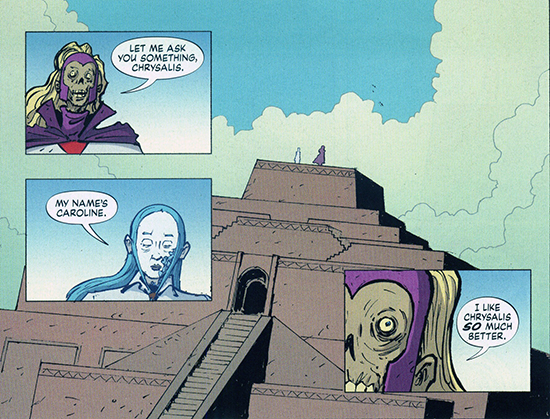
VISAGGIO: I always want it to be, “I’ve got Trans characters, and that’s relevant to who they are, but it’s not relevant to the plot — except inasmuch as their characters are relevant to the plot.” I don’t want Trans stuff to be this big blinking light. Right now there’s so much amazing wok coming out from Trans writers that concerns the Trans experience in ways that are very grounded and realistic and genuine. You’re not just getting the same fucking story [as in] mainstream literature and television and film. There’s this writer Casey Plett who has this short story collection called A Safe Girl to Love, and it’s all these wild, varied, different ways of experiencing being Trans. Casey has a story in there about this twentysomething-year-old Trans girl whose mom is also Trans, which is a thing that happens now and then, and their weirdly conflicted relationship over that fact, and how the mother is super-reluctant about her daughter’s transition because she knows how shitty it is being Trans, and she doesn’t want her to romanticize it, so there’s this sort of generational gap, and the difficulties between them that arise from that. That’s a complicated vision of being Trans that you NEVER SEE.
HILOBROW: It never gets past the baseline of, “this is what Trans means,” as a tutorial for straight people.
VISAGGIO: What’s interesting to me, is stuff that takes the Transness of the characters for granted, and then uses that to move forward with other elements. So looking at someone like Dani — Dani is someone whose Transness is taken for granted, and is used to illuminate not a transition as such, but an existential decision regarding one’s life — not what kind of life you’re going to live, but whether you are going to live one at all. Whether her existence is worth continuing.

HILOBROW: One of the things I found most interesting about Dani is that she’s reached a point of self-confidence and inner certainty which then kind of equips her to deal with what’s going on inside the head of Caroline, who’s on a cosmic level almost. To me that signified that yes, there will always be extra, further steps in expanding the circle of human concern, and that there are more profound implications about identity — who you choose to be, how you choose to be — that are beyond the merely physical or the merely material. So to have Dani as a character who stands on that ledge and looks out and kind of calls some advice to the character of Caroline who’s literally hanging in the air I thought was very powerful.
VISAGGIO: We were able to take a Trans experience and relate it to this universal thing. Relate it to elements of mental health, to elements of depression…and not centering her Trans narrative per se I think we were able to universalize the experience being communicated.
HILOBROW: You gave everyone the space to be an individual. And communication is the key — Rick thinks he can “talk her down,” but still it’s a form of talking-down-to I guess.
VISAGGIO: Dani’s not lecturing. She’s actually communicating. And she’s the only one who’s not saying to Caroline, “You have to FIX this. You have to clean up your fucking mess.” She’s the only one who’s not bossing her around, judging her, trying to “fix” her. She’s just there because she’s her friend, and she wants to be there for her, because she’s hurting. And no one else is trying to do that. Rick gets called in by her boss after her boss has already berated her; her therapist is someone she’s only seeing because she’s compelled to — Dani’s the one person who’s in her life voluntarily.
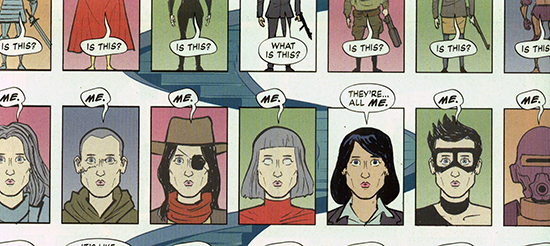
You can choose Eternity Girl either in periodical (issues 1-6 are still available from DC Comics/Young Animal) or book form (the full series collection will release on December 4 this year).
Panel Zero logo designed by Steve Price
MORE COMICS-RELATED SERIES: Douglas Wolk’s LIMERICKANIA | KIRB YOUR ENTHUSIASM — 25 writers on 25 Jack Kirby panels | ANNOTATED GIF — Kerry Callen brings comic book covers to life | COMICALLY VINTAGE — that’s-what-she-said vintage comic panels | DC — THE NEW 52 — an 11-year-old reviews DC’s new lineup | SECRET PANEL — Silver Age comics’ double entendres | SKRULLICISM — they lurk among us | Douglas Wolk’s THAT’S GREAT MARVEL, TAKING LIBERTIES, STERANKOISMS, MARVEL vs. MUSEUM, LIMERICKANIA, WTC WTF
MORE POSTS by ADAM McGOVERN: OFF-TOPIC (2019–2025 monthly) | textshow (2018 quarterly) | PANEL ZERO (comics-related Q&As, 2018 monthly) | THIS: (2016–2017 weekly) | PEOPLE YOU MEET IN HELL, a 5-part series about characters in McGovern’s and Paolo Leandri’s comic Nightworld | Two IDORU JONES comics by McGovern and Paolo Leandri | BOWIEOLOGY: Celebrating 50 years of Bowie | ODD ABSURDUM: How Felix invented the 21st century self | CROM YOUR ENTHUSIASM: C.L. Moore’s JIREL OF JOIRY stories | KERN YOUR ENTHUSIASM: Data 70 | HERC YOUR ENTHUSIASM: “Freedom” | KIRK YOUR ENTHUSIASM: Captain Camelot | KIRB YOUR ENTHUSIASM: Full Fathom Five | A 5-part series on Jack Kirby’s Fourth World mythos | Reviews of Annie Nocenti’s comics Katana, Catwoman, Klarion, and Green Arrow | The curated series FANCHILD | To see all of Adam’s posts, including HiLo Hero items on Lilli Carré, Judy Garland, Wally Wood, and others: CLICK HERE
